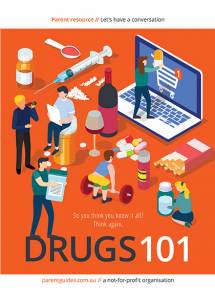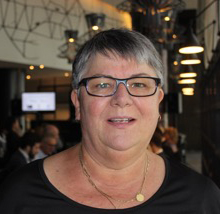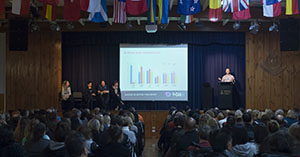By Cheryl Critchley
 Hallucinogens, such as LSD, were popular with young people during the 1960s and 1970s “flower power” era. While many more drugs have been developed since, LSD is still available in Australia.
Hallucinogens, such as LSD, were popular with young people during the 1960s and 1970s “flower power” era. While many more drugs have been developed since, LSD is still available in Australia.
Hallucinogen use among young people is relatively uncommon; about 3 per cent of Australian high-school students report having tried them.
Also known as “psychedelics”, hallucinogens can make you see, hear, smell, feel or taste things that aren’t really there or are different from reality, hence the word hallucinate. LSD (Lysergic acid diethylamide) is made in a laboratory and in its pure state is a white odourless powder.
It usually comes in squares of gelatine or blotting paper that have been dipped or soaked in LSD and is sometimes sold as a liquid, in a tablet or capsules. LSD is usually swallowed, but it can also be sniffed, injected or smoked. Some plants, such as magic mushrooms, can cause similar hallucinations to chemically produced hallucinogens.
OTHER NAMES
LSD, acid, trips, tabs, microdots, dots, magic mushrooms, shrooms, mashies, blue meanies, gold tops, liberty, mescaline, cactus, cactus buttons, cactus joint, mess, mescal
WHO USES HALLUCINOGENS?
The 2011 Australian secondary students’ survey found 3 per cent had used hallucinogens such as LSD. The proportion increased with age, from 1 per cent of 12-year-old students to 7 per cent of 17-year-olds. Only 2 per cent of all students reported having used hallucinogens in the past year and only 1 per cent had used them in the previous month.
Boys were generally more likely than girls to use them, particularly at ages 15 and 17. Most of the 2 per cent of students who reported using hallucinogens in the previous year did so infrequently.
FOUND IN NATURE
Magic Mushrooms
There are many different types of magic mushrooms. In Australia, the most common is called golden tops, blue meanies and liberty caps. Magic mushrooms look similar to poisonous mushrooms that can cause sickness and possible death. They are usually collected and then sold as dried mushrooms, powder or as capsules. The mushrooms can be eaten fresh, cooked or brewed into a tea. They are sometimes mixed with tobacco or cannabis and smoked.
Mescaline (Peyote Cactus)
Mescaline is the active ingredient of the peyote cactus plant. It contains “buttons” that can be cut from the root and dried before eating or smoking. It can also be produced synthetically. In its pure form, mescaline sulphate is a white crystal-like powder. Synthetic mescaline comes in different colours.
Are magic mushrooms less dangerous than LSD?
Magic mushrooms have similar effects to LSD. They contain psilocybin, which belongs to the same chemical family as LSD. It is dangerous to pick and eat wild mushrooms because they are difficult to distinguish from edible mushrooms. Poisonous mushrooms can cause stomach pains, vomiting and diarrhoea; some can cause permanent liver damage, respiratory failure, unconsciousness and even death. Symptoms can take up to 40 hours to develop.
A BAD TRIP
In some cases, hallucinogen users experience a “bad trip” involving a disturbing hallucination. This can lead to panic and risky behaviour, like running across a road or attempting suicide.
If a large amount or a strong batch is taken, the negative effects of hallucinogens are more likely.
SHORT & LONG TERM EFFECTS
View the Australian Drug Foundation’s short and long term effects of hallucinogens here.
Drugs 101 is an informative resource that offers expert advice about drugs and how to start a conversation about them with your kids. It profiles people touched by addiction and explains what drugs are, how they work, their risks and how many young people use them.
Click here to purchase a copy.





Comments (114)
Comments are closed.